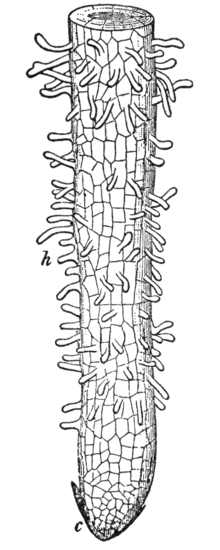The New Student's Reference Work/Root

Root. True roots are developed only by vascular plants, that is, by Pteridophytes (fern-plants) and Spermatophytes (seed-plants). They act either as holdfasts or as absorbing organs or as both. The ordinary soil-roots serve both for anchorage and for absorbing. In structure roots are all alike in general plan, whether they belong to ferns or to pines or to the true flowering plants. Each root consists of an epidermis, a more or less thick cortex and a central, solid, woody cylinder or axis. In the soil-roots a peculiar cap of dead cells covers the delicate growing tip, known as the root-cap. This cap protects the delicate tip-cells as the root burrows through the soil, and it is renewed from beneath as fast as it is worn off on the outside. To aid roots in absorbing, the epidermal cells just behind the root-cap send out long hair-like processes known as root-hairs, which immensely increase the absorbing surface. These root-hairs are very ephemeral, being present only near growing tips and rapidly disappearing from older parts. It is only the youngest roots which have this typical root-structure and do the work of absorption. As a root increases in age, it becomes very much modified in its structure and ceases to absorb, being then merely a channel through which the absorbed material passes to the stem and leaves.